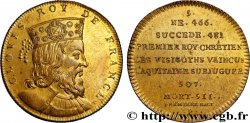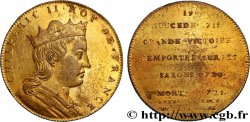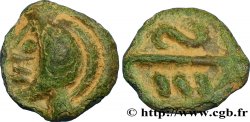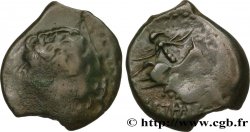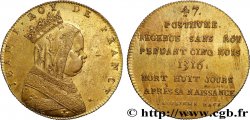fjt_1014585 - SÉRIE MÉTALLIQUE DES ROIS DE FRANCE Règne de JEAN I LE POSTHUME - 47 - Émission de Louis XVIII n.d.
Nicht verfügbar.
Artikel auf unserem Online-Shop verkauft (2025)
Preis : 35.00 €
Artikel auf unserem Online-Shop verkauft (2025)
Preis : 35.00 €
Type : Règne de JEAN I LE POSTHUME - 47 - Émission de Louis XVIII
Datum: n.d.
Metall : Messing
Durchmesser : 31,5 mm
Stempelstellung : 12 h.
Gewicht : 10,73 g.
Rand Cannelée
Seltenheitsgrad : R1
Kommentare zum Erhaltungszustand:
De l’usure sur les reliefs, irrégularité de la forme, taches brunes au revers. Joli brillant de frappe encore visible
Vorderseite
Titulatur der Vorderseite JEAN I ROY DE FRANCE.
Beschreibung Vorderseite Buste imaginaire du bébé enmailloté couronné portant un châle fleurdelysé à droite.
Rückseite
Titulatur der Rückseite 47 - POSTHUME REGENCE SANS ROY PENDANT CINQ MOIS 1316 MORT HUIT JOURS APRES SA NAISSANCE TROISIEME RACE / N..
Beschreibung Rückseite en huit lignes.
Kommentare
Jean Ier de France, dit le Posthume, roi de France et roi de Navarre, était fils posthume de Louis X le Hutin et de Clémence de Hongrie. Né dans la nuit du 14 au 15 novembre 1316, il ne vécut que cinq jours. Il fut enterré dans la basilique de Saint-Denis. Le comte de Poitiers, alors régent, fut proclamé roi de France sous le nom de Philippe V.
La mort prématurée de Jean Ier amena le premier problème de succession de la dynastie capétienne.
Quand Louis X le Hutin, son père, mourut sans fils pour lui succéder, c'était la première fois depuis Hugues Capet que la succession de père en fils des rois de France était interrompue. On décida alors d'attendre que la reine Clémence, qui était enceinte, mette son enfant au monde. Et pour l'heure, le frère du roi, Philippe, fut chargé de la régence du royaume contre son oncle Charles de Valois. La naissance d'un enfant mâle était donc très attendue pour donner à la France son roi.
Pour la suite de la biographie, voir http://fr.wikipedia.org/wiki/Jean_Ier_de_France on notera que cette fiche est aussi illustrée avec notre jeton.
John I of France, known as the Posthumous, King of France and King of Navarre, was the posthumous son of Louis X the Quarrelsome and Clémence of Hungary. Born on the night of November 14-15, 1316, he lived only five days. He was buried in the Basilica of Saint-Denis. The Count of Poitiers, then regent, was proclaimed King of France under the name Philip V. The premature death of John I brought about the first succession problem for the Capetian dynasty. When Louis X the Quarrelsome, his father, died without a son to succeed him, it was the first time since Hugh Capet that the succession of the kings of France from father to son had been interrupted. It was then decided to wait until Queen Clémence, who was pregnant, gave birth to her child. And for the time being, the king's brother, Philip, was entrusted with the regency of the kingdom against his uncle Charles of Valois. The birth of a male child was therefore highly anticipated to give France its king. For the rest of the biography, see http://fr.wikipedia.org/wiki/Jean_Ier_de_France. Note that this file is also illustrated with our token.
La mort prématurée de Jean Ier amena le premier problème de succession de la dynastie capétienne.
Quand Louis X le Hutin, son père, mourut sans fils pour lui succéder, c'était la première fois depuis Hugues Capet que la succession de père en fils des rois de France était interrompue. On décida alors d'attendre que la reine Clémence, qui était enceinte, mette son enfant au monde. Et pour l'heure, le frère du roi, Philippe, fut chargé de la régence du royaume contre son oncle Charles de Valois. La naissance d'un enfant mâle était donc très attendue pour donner à la France son roi.
Pour la suite de la biographie, voir http://fr.wikipedia.org/wiki/Jean_Ier_de_France on notera que cette fiche est aussi illustrée avec notre jeton.
John I of France, known as the Posthumous, King of France and King of Navarre, was the posthumous son of Louis X the Quarrelsome and Clémence of Hungary. Born on the night of November 14-15, 1316, he lived only five days. He was buried in the Basilica of Saint-Denis. The Count of Poitiers, then regent, was proclaimed King of France under the name Philip V. The premature death of John I brought about the first succession problem for the Capetian dynasty. When Louis X the Quarrelsome, his father, died without a son to succeed him, it was the first time since Hugh Capet that the succession of the kings of France from father to son had been interrupted. It was then decided to wait until Queen Clémence, who was pregnant, gave birth to her child. And for the time being, the king's brother, Philip, was entrusted with the regency of the kingdom against his uncle Charles of Valois. The birth of a male child was therefore highly anticipated to give France its king. For the rest of the biography, see http://fr.wikipedia.org/wiki/Jean_Ier_de_France. Note that this file is also illustrated with our token.








 Berichten über einen Fehler
Berichten über einen Fehler Die Seite drucken
Die Seite drucken Teilen meiner Auswahl
Teilen meiner Auswahl Stellen Sie eine Frage
Stellen Sie eine Frage Einlieferung/Verkauf
Einlieferung/Verkauf
 Details
Details
